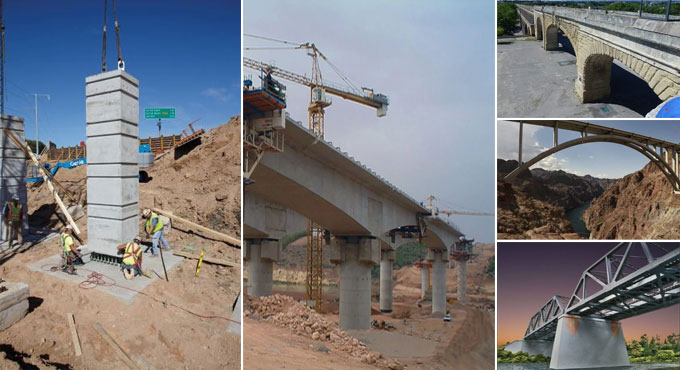
Bridges and Bridge Piers
Prologue to Bridges: Individuals have been building bridges for around 4,000 years. The most seasoned and as yet existing bridge on the planet is maybe the Zhaozhou Bridge in Hebei Province in China, initially built around in A.D. 600.
In any case, bridge plan and development at that point may not be viewed as bridge designing practice according to today. Rather, work was done dependent on experience instead of quantitative arranging as done at this point.
Bridge designing today utilizes math based examination and definite arranging. Materials utilized in bridge development have additionally changed observably through a decent number of years, from chiefly common materials, for example, stones and wood than to basically man-made materials, for example, steel and Portland concrete solid today.
Because of extraordinary improvement in the quality and creation quality control of these materials, bridge segments have decreased, become more slender, skinnier, and lighter to lessen self-weight and be more practical.
In 1866 Ways and Koenen in Germany led a progression of tests on strengthened solid bars (Heins and Lawrie, 1984), which began the time of cement for bridge development. More tests and exploration work were done in the next decades. The principal bridge utilizing strengthened cement on the planet was credited to Monier in 1867 (Heins and Lawrie, 1984).
The primary bridges utilizing steel are accepted to be built in the United Kingdom and the United States during the 1880s. These spearheading ventures started what is referred to today as current bridge building. Another significant angle describing modem bridge designing is the instruments used to perform quantitative displaying and arranging.
They incorporate math and analytics based mechanics, recognized as the establishment of modem bridge building as rehearsed today. This information was built up in the seventeenth century. With the new materials and propelled examination devices, the quick advancement of modem bridge building had its specialized quality.
The fuel for significant improvements of bridge designing was the need or want for monetary turn of events, For instance, the present roadway bridge innovation in the United States is to a great extent an aftereffect of the fast advancement of the interstate parkway framework during the 1950s and 1960s after World War II.
As an item, a far reaching parkway framework has been set up, comprising around 50,000 miles of streets and around 600,000 bridges.
It is likewise intriguing to make reference to that various creating nations are right now encountering a comparable "blast" in their surface transportation frameworks. This has become the main impetus for bridge designing improvement in those pieces of the world.
Parts of Bridge Structures:
1. Superstructure
2. Decks
3. Bearings
4. Foundation
5. Girder or Beam
6. Substructure Components
7. Bridge Tower
8. Pier Cap
9. Pier
10. Pile Cap and Piles
11. Bridge Anchor
12.Suspension Cable
What is a Pier?
The piers give vertical backings to ranges at the middle of the road of various focuses and perform both principle capacities: moving vertical superstructure loads to the establishments and opposing flat powers following up on this bridge.
In spite of the fact that piers are intended to oppose vertical loads, it is getting regular to plan piers into opposing high horizontal loads brought about by seismic occasions. Indeed, even in some low seismic territories, architects are giving more consideration to this pliability part of the structure.
These Piers are prevalently built utilizing strengthened cement. This Steel, less significantly, is additionally utilized for piers. The Steel tubes loaded up with solid segments have increased more consideration as of late.
The piers or segments for customary bridges, for example, grade partitions, overcrossing, overheads, underpasses, and basic waterway intersections. Fortified solid sections will be talked about in detail, while steel and composite segments will be quickly examined. Foundations for curve, suspension, segmental, link stayed, and mobile bridges are rejected from the bases for a portion of these unique kinds of bridges.
Classification of Bridge:
Bridges by Structure: Curve Bridges, Bar Bridges, Support Bridges, Cantilever Bridges, Tied Arch Bridges, Engineered overpasses, Link Stayed Bridges
Fixed or Moveable Types: Fixed Bridges, Impermanent Bridges, Moveable Bridges, Passerby Bridges
Passerby Bridges: Twofold decked Bridges, Train Bridges, Pipeline Bridges, Water channels, Business Bridges


